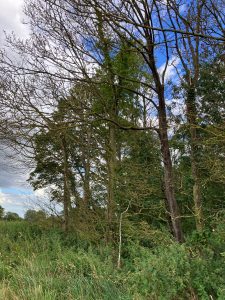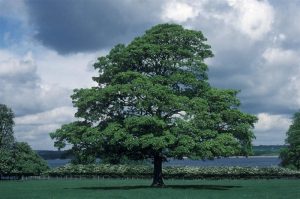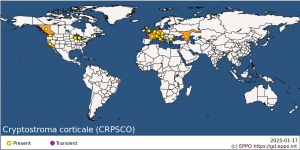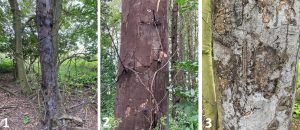
Sooty bark disease is a fungal disease of maple trees, which causes rapid wilting and mortality particularly in sycamore (Acer pseudoplatanus). In addition, it can have implications for human health if fungal spores are inhaled. The disease is caused by the fungus Cryptostroma corticale, which is known to have been present in the UK since 1945, and was probably imported during the second World War from North America. It is most often noticed after periods of hot weather when extensive black sooty patches are revealed beneath the bark of affected trees. It is a disease which needs high temperatures for extended periods of time and therefore is expected to become more prevalent in the UK if the pattern of above-average summer temperatures continues.
Hosts

- Acer pseudoplatanus (Sycamore)
- Acer campestre (Field maple)
- Acer platanoides (Norway maple)
- Acer negundo (Box elder)
- Acer rubrum (Red maple)
- Acer macrophyllum (Big leaf maple)
- Acer palmatum (Japanese maple)
- Aesculus hippocastanum (Horse chestnut)
- Cornus nuttallii (Pacific dogwood)
There are also records in scientific literature on Euonymus europaeus (European spindle), Populus tacamahaca x trichocarpa (hybrid balsam poplar), Salix viminalis (osier), Viburnum opulus, hickory and linden.
Distribution
The current global distribution is illustrated on the map in figure 1 which is generated by the European Plant Protection Organisation (EPPO)

Disease presence has been confirmed in the following countries:
- Canada 1898
- USA 1898
- UK 1945
- Italy 1990
- Germany 2005
- Austria 2003
- Switzerland 2003
- Czech Republic 2005
- France 2005
- The Netherlands 2013
- Bulgaria 2014
- Belgium 2018
Progress of the disease
The fungus probably enters through wounds or infects small branches and twigs. It then colonises the tree, growing longitudinally and potentially coexisting with the host as an endophyte. This colonised wood is stained an olive green to brown colour and is apparent if a cross-section of the wood is made. When the temperature increases (as seen in the hot summers of 1975, 2017 and 2018) and exceeds an average of 25oC for an extended period of time, Cryptostroma is able to grow radially and it expands out from the column of colonised wood. The tree then wilts and begins to die. Upon reaching the cambium it kills the tissue and a layer of fungal cells called the stroma forms to produce enormous numbers of spores beneath the bark. The bark falls away to reveal this black powdery layer and the spores are dispersed aerially. Once these spores have been released, the remaining fungal surface has a greyish appearance.

- Symptoms on stem
- Close-up of spore mass on stem
- More silvery appearance of stroma once spores have been released
Health considerations
Cryptostroma corticale is an allergen and, due to the many billions of spores which are produced, can cause health problems if the spores are inhaled. An article in the Journal of Occupational Medicine and Toxicology reviewed the risk of hypersensitivity pneumonitis. It is therefore advisable to remove affected trees if there is likelihood of human exposure, but this should be done with caution in order to minimise human exposure to spores, and protect those carrying out the tree work and others in the vicinity. The UK Forest Industry Safety Accord (UKFISA) A reminder on Sooty Bark Disease (ukfisa.com) provides health and safety advice and recommendations including:
- Appropriate Personal Protective Equipment should be worn to reduce spore inhalation
- Ideally work should be carried out when the weather is damp to reduce spore dispersal
- Public access during works should be restricted
- In a forestry situation, mechanical harvesting is advised
- Infected logs should not be kept for use as firewood
Implications for UK sycamores
Cryptostroma corticale is not associated with disease in the Great Lakes where it was first recorded and following its discovery in Europe it has not been associated with extensive Acer mortality. After hot summers, there have been occurrences of small numbers of maples dying, but these have been sporadic and geographically isolated.
However, more recently in Austria sooty bark disease has been associated with the infection of 60% of sycamores in a forestry stand north of Vienna. There have also been a significant number of reports of Acers with sooty bark disease in Germany, the Netherlands and Belgium in recent years. In the Seattle area, Washington, USA there have also been a number of records of sycamores and other tree species being affected since 2020 and this may represent an emerging problem.
Although this may be an increasing problem for mature trees, the long-term prospects for sycamore in the UK could be improved by always planting it in mixtures with other species, as recommended by Strouts and Winter (2004).
Reporting cases
If you believe that you have an Acer which might be affected by sooty bark disease, please report it through TreeAlert. The Tree Health Diagnostic and Advisory Service are keen to record cases of the disease to track whether its geographical distribution and/or incidence is increasing in the UK.
